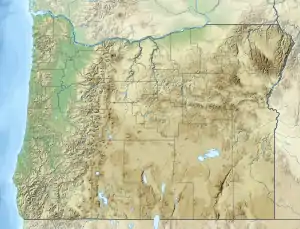South Fork Wenaha River
The South Fork Wenaha River is a tributary of the Wenaha River in the U.S. state of Oregon.[4] The river begins in the Blue Mountains south of Bone Spring in Wallowa County near its border with Union County. From there it flows generally northeast through the Wenaha–Tucannon Wilderness of the Umatilla National Forest to meet the North Fork Wenaha River. The combined forks form the main stem Wenaha, a tributary of the Grande Ronde River.[5]
| South Fork Wenaha River | |
|---|---|
 Location of the mouth of the South Fork Wenaha River in Oregon | |
| Etymology | Perhaps from a Cayuse language placename[1] |
| Location | |
| Country | United States |
| State | Oregon |
| County | Wallowa |
| Physical characteristics | |
| Source | Blue Mountains |
| • location | near Bone Spring, Wenaha–Tucannon Wilderness |
| • coordinates | 45°52′32″N 117°56′17″W[2] |
| • elevation | 5,723 ft (1,744 m)[3] |
| Mouth | Wenaha River |
• location | Wenaha Forks |
• coordinates | 45°57′03″N 117°47′39″W[2] |
• elevation | 2,805 ft (855 m)[2] |
Named tributaries of the South Fork Wenaha from source to mouth are Milk and Trapper creeks followed by Cougar Canyon. Then come Jaussard and Elk creeks.[5]
Recreation
The main path along the South Fork is the Wenaha River Trail, a 31-mile (50 km) route with trailheads at Troy and Timothy Springs. It runs parallel to the main stem between Troy and Wenaha Forks and roughly parallel to the South Fork upstream of the confluence. This trail connects to other wilderness paths: Elk Flat, Hoodoo, and Cross Canyon trails.[6]
The trail system is used by hikers, backpackers, and horse riders. It offers panoramic views, access to fishing, and suitable spots for dispersed camping. It is also remote, involves significant elevation changes, can be extremely hot in summer, and is frequented by rattlesnakes.[6]
See also
References
- Bright, William (2004). Native American Placenames of the United States. Norman: University of Oklahoma Press. p. 561. ISBN 0-8061-3576-X.
- "South Fork Wenaha River". Geographic Names Information System (GNIS). United States Geological Survey. November 28, 1980. Retrieved January 13, 2016.
- Source elevation derived from Google Earth search using GNIS source coordinates.
- Palmer, Tim (2014). Field Guide to Oregon Rivers. Corvallis: Oregon State University Press. p. 291. ISBN 978-0-87071-627-0.
- "United States Topographic Map". United States Geological Survey. Retrieved January 13, 2016 – via Acme Mapper.
- "Wenaha River Trail #3106". United States Forest Service. Retrieved January 13, 2016.